Special Exhibitions are held throughout the year.
Each year, we put together a Special Exhibition on a different topic, creating a thirty-minute video which we show on our large projection screen in the Special Exhibition Area of the Upper Level. You can also find touch panel information screens which introduce atomic bomb accounts and other information about the topic, as well as displays of related materials and artifacts.
We offer DVD rental services of past and present Special Exhibition videos (from 2013 and later). Apply via fax or online via e-mail.
Current Special Exhibition
Special Exhibition Commemorating 80 Years: Preserving the Past, Sharing the Stories: The Tragedy of Hiroshima and the Voices of Hibakusha
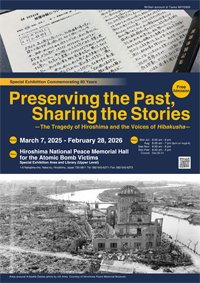
The Hiroshima National Peace Memorial Hall for the Atomic Bomb Victims has collected, preserved, and made publicly available over 150,000 personal accounts of the atomic bombing. Eighty years have passed since the bombing, yet these handwritten accounts of hibakusha continue to convey the harsh reality of the atomic bomb's devastation. This special exhibition shares the tragedy of Hiroshima and the experiences of hibakusha through their personal accounts, together with videos and historical materials.
Exhibition Period
March 7, 2025 - February 28, 2026
From Saturday, March 1 to Thursday, March 6, the exhibit will be temporarily relocated to Seminar Room 3 while the new display is being set up.
Exhibition Venue
Hiroshima National Peace Memorial Hall for the Atomic Bomb Victims
Special Exhibition Area and Library (Upper Level)
Featured Exhibits
(1) Accounts of the Atomic Bomb
Personal accounts of hibakusha, which vividly describe the circumstances of the atomic bombing, are available in four languages: Japanese, English, Chinese, and Korean.
(2) Documentary Video
A documentary video (approx. 20 min.) featuring hibakusha testimonies and drawings of the atomic bombing will be shown to introduce accounts of the Atomic Bomb.
(3) Other Materials
Original manuscripts of the accounts and related materials will be displayed in the exhibition hall.
▶ The exhibition video will be released soon.
Past Special Exhibitions
2025(8/1-8/31)
Special Exhibition Commemorating 80 Years
Within 3 Kilometers of the Hypocenter - That Moment: Testimonies from Hibakusha (Atomic Bomb Survivors) -
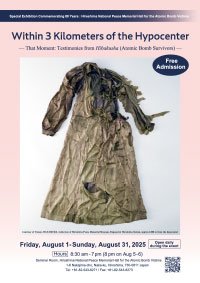
At 8:15 a.m. on August 6, 1945, an atomic bomb was dropped, and exploded approximately 600 m above Shima Hospital, which stood about 160 m from what is now the Atomic Bomb Dome. The city of Hiroshima was instantly reduced to ruins. In the case of Hiroshima, the atomic bomb exploded at the center of a flat city. Thus, the extent of the damage can be categorized by concentric circles radiating from the hypocenter. This special exhibition, organized by distance from the hypocenter, conveys the destructive effects of the atomic bomb's heat rays, blast, and radiation through the personal accounts of A-bomb survivors (hibakusha) and historical materials.
2024(2024/3/1-2025/2/28)
Akatsuki Corps in the Face of Apocalyptic Fires: Hiroshima and the Child Soldiers of the Suicide Attack Squad
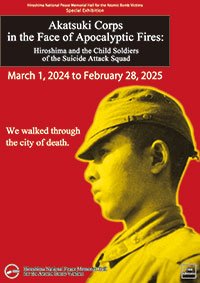
At the end of the Pacific War, the child soldiers of the special cadet program who were assigned to the Army Marine Headquarters (known as the Akatsuki Corps) were assembled on Etajima Island and began training for suicide attacks upon enemy ships using a single-seater plywood motorboat known as a Maru-Re.
Although they were well aware of their certain deaths, what awaited them was not a suicide attack, but the atomic bombing of Hiroshima on August 6, 1945. They were ordered to rush to city of Hiroshima and provide aid even if it meant disregarding their main duties, but what did they see and feel in the city of death? This special exhibit will explore their thoughts and experiences.
2023 (2023/3/15-2024/2/29)
A Blank in the Weather Map: The Hiroshima of the Weather Experts
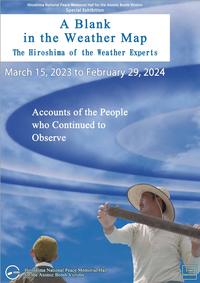
On August 6, 1945, the atomic bomb inflicted enormous damage on the city of Hiroshima. At the Hiroshima Regional Meteorological Observatory, located approximately 3.7 km south of the hypocenter, the windows facing the hypocenter were shattered, and many of the staff members were seriously injured.
Even under such circumstances, three young staff members went to the center of the city to telegram the latest meteorological data to the Central Meteorological Observatory, believing that "those in charge of meteorological observations must continuously keep track of changes in weather events over time." What they found there, however, was a veritable hellscape.
In addition, Typhoon Makurazaki swept through Hiroshima just one month later, making the damage from the atomic bombing even more serious. In order to pass on the lessons of this double disaster to future generations, the meteorological observatory staff members visited the area to conduct detailed interviews with survivors and compiled their findings into a valuable research report.
This exhibition will explore the reality of the atomic bombing from the perspective of the observatory staff through their personal accounts of the bombing.
2022 (3/1-12/29)
Trembling Gazes: The Message Left Behind by A-bomb Photographers
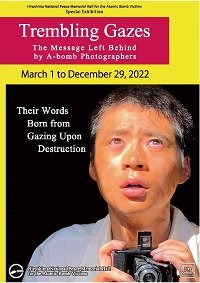
On August 6, 1945, when the atomic bomb was dropped on Hiroshima, there were people who were able to catch the rising mushroom cloud on camera. With no way of knowing that it was caused by the first atomic bomb ever used, the photographers instinctively captured the tremendous scene happening before their eyes. Toshio FUKADA, then 16 years old, explains, "Since I had a camera, I wanted to document the truth as it happened."
How did these photographers from completely different professions and positions in life, including a cameraman in the military, a proprietor of a photo studio, and a junior high school student working for a newspaper, manage to capture on film the tragic aftermath of the atomic bombing seen in their viewfinders while suppressing their urge to look away? This exhibition also highlights how they expressed their experiences in words with their keen descriptive abilities.
2022 Anniversary Special Exhibition (8/1-8/31)
20th Anniversary Special Exhibition--Family Portraits: Bonds Torn Apart
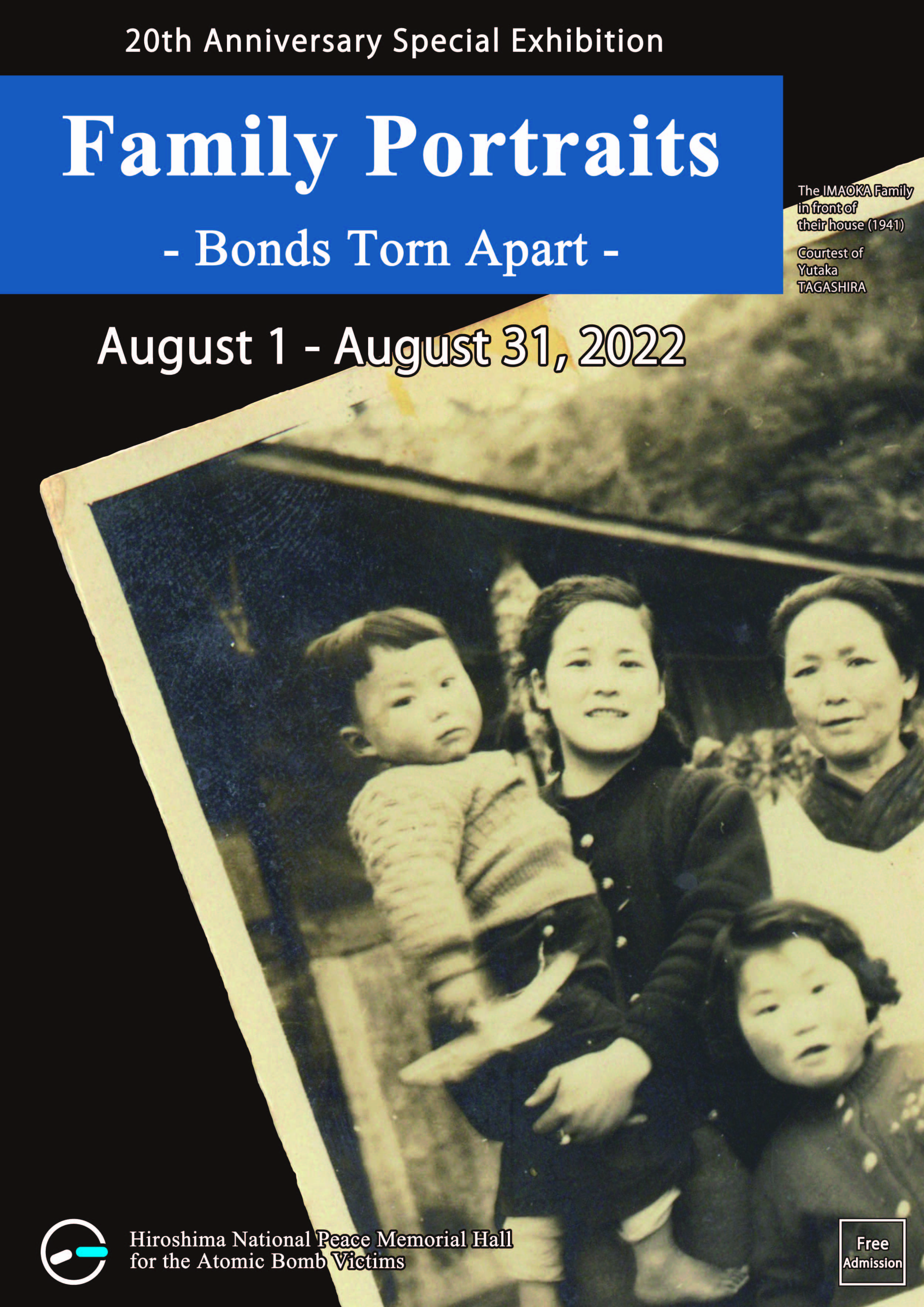
This year marks the 20th anniversary of the Hiroshima National Peace Memorial Hall for the Atomic Bomb Victims, which opened on August 1, 2002. Since its opening, the Memorial Hall has registered and displayed the names and photographs of those who died in the atomic bombing. While registering photographs of the deceased, we often receive family photos, all of which have been carefully preserved.
For this special exhibition, we have selected nearly 200 family photos taken before the bombing and will display them in the Hall of Remembrance, the circular space with a circumference of about 55 meters, located on the lower level of the Memorial Hall.
Under the steady gaze of the people in these photographs, visitors will be able to recognize the horror of the atomic bomb, which not only brought instant death but also tore apart entire generations, and the value of peace.
In addition, we will highlight the stories of six families from these family photos in the Library on the upper level.
2021 (2021/3/1-2022/2/28)
Commitment: The Priests of Hiroshima and the Road to Recovery
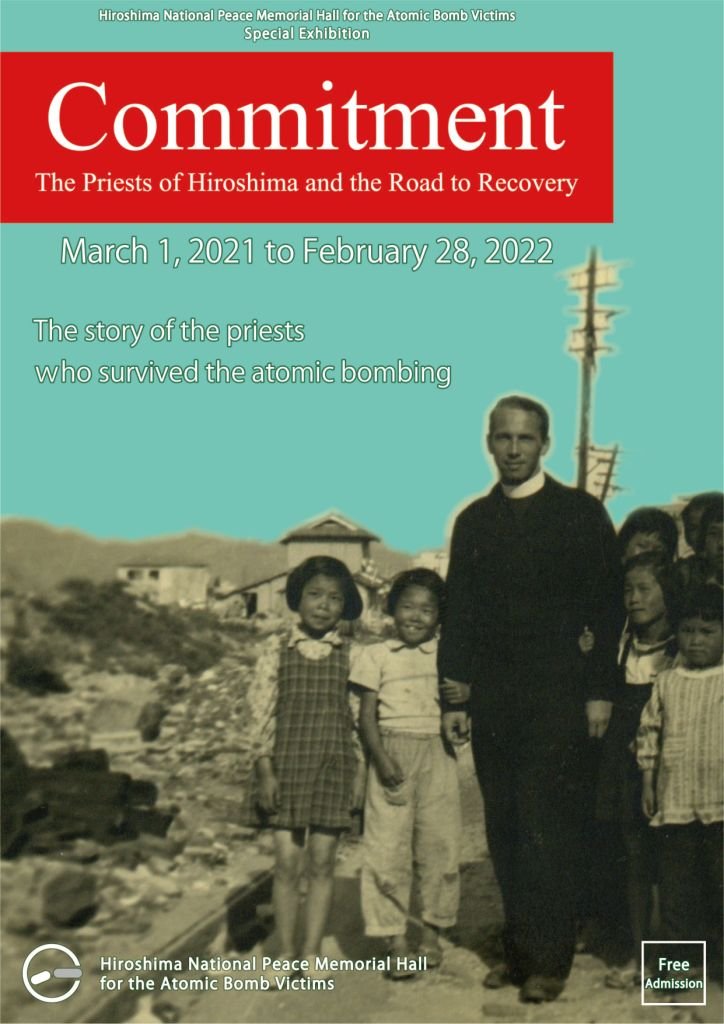
When the atomic bomb was dropped on Hiroshima on August 6, 1945, there were four foreign Jesuit priests at the Nobori-cho Catholic Church (1.2 kilometers from the hypocenter). While two suffered grave injuries, they worked together to save the people in the church and their neighbors.
At the same time, in a suburb of Hiroshima City, nearly 100 survivors of the bombing came to the Nagatsuka Jesuit Novitiate (4.5 kilometers from the hypocenter) in search of aid, and by the afternoon of August 6, the novitiate had become a field hospital. The superior of the Nagatsuka Novitiate, Father Arrupe, had majored in medicine at university, and turned his chamber into an operating room, believing that now was the time to put his medical knowledge to use. Together with the other priests and nuns, he worked to treat the victims day and night without rest.
This special exhibition traces the recovery of Hiroshima through the testimonies of several priests from overseas who were living in the city.
2020 (2020/1/1-2021/2/28)
A Tale of Two Brothers Across Time — Hiroshima Artist Gorō SHIKOKU and the Diary of Naoto on His Deathbed
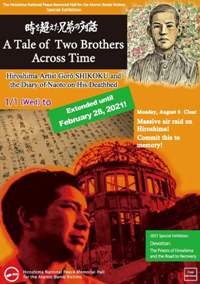
Gorō SHIKOKU (1924-2014) dedicated his artistic talents to the anti-war and anti-nuclear weapons movements, inspired by the death of his beloved younger brother, Naoto (1927-1945), who passed away at the young age of 18 as a victim of the atomic bombing.
"I'll create art on behalf of all of those who lost their lives; art which calls for the end of war and of nuclear weapons. This is what's important--I don't care if it's considered art or not..."
The death of his younger brother changed his entire life.
This special exhibition brings to life the story of two brothers across time through passages in Naoto's diary written from the day of the bombing until the day he died, and through pieces of art which his older brother Gorō went on to create.
2019 (1/1-12/29)
Lantern Floating: Memorial for the A-bombing at Hiroshima Ichijo — Records from a girls high school that suffered the greatest sacrifice
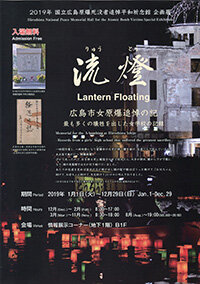
As the war situation worsened, classes for students, whose ages were the same as or older than present-day junior high school students, were canceled from April 1945. The students were mobilized for food production and munitions factories throughout the year. Approximately 7,200 children fell victim to the bombing in Hiroshima: above all, students who were engaged in building demolition work outdoors near the hypocenter suffered serious damage. Especially, with most of its first- and second-year students having been mobilized, and 666 students having passed away, Hiroshima Municipal Daiichi Girls High School (commonly known as Ichijo, and today called Hiroshima Municipal Funairi High School) became the school which suffered the greatest sacrifice.
In August 1957, which marks the 12th anniversary of their deaths, Lantern Floating, a collection of essays in memory of A-bomb victims, was issued by bereaved families. This collection is a detailed record of the processes from student mobilization to the end of the war, and includes memoirs of bereaved families and posthumous writings of the deceased students. In this special exhibition, portraits of victims and related materials will be displayed focusing on memoirs appearing in Lantern Floating, conveying the tragedy of the war and the atomic bombing, as well as wishes for peace.
2018 (1/1-12/29)
The Twinkling Stars Know Everything: Collection of Memories by Fathers and Mothers of the Annihilated First-Year Hiroshima Itchu Students
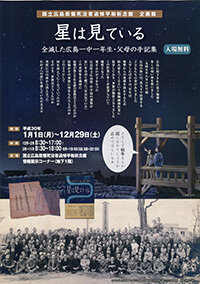
The atomic bomb dropped on Hiroshima deprived many children of their precious lives. In the streets of Hiroshima early in the morning of August 6, 1945, there were children engaged in labor service under a blazing sky. They were first-year students who had just entered Hiroshima Prefectural Hiroshima Daiichi Junior High School. They were engaged in creating a firebreak to prevent the spread of fire caused by possible air raids—this activity resulted in claiming the lives of so many children.
The Twinkling Stars Know Everything is a collection of sentimental memoirs written by the bereaved families of the students of Hiroshima Prefectural Hiroshima Daiichi Junior High School: they lost their beloved sons, many of whom were engaged in this labor service at the time of the atomic bombing. How had the families lived their lives before the atomic bomb was dropped? What did the bombing bring to the families? How did the students pass away, and what did they call for in their final moments? What did their families do at that time? Based on this collection of memoirs, the exhibition will help you experience the feelings the parents had for their sons, who suddenly vanished from this earth.
2017 (1/1-12/29)
Memoirs of the Atomic Bombing: The Earliest Accounts of the Hiroshima A-bomb, Part 2
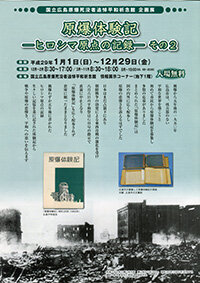
In 1950, five years after the bombing, Hiroshima City invited its residents to send stories of their experience with the atomic bomb in order to share them with others and thereby help create a peaceful world free from nuclear weapons. A total of 165 stories were collected, and of those, 18 stories were chosen to be compiled into a publication titled, Memoirs of the Atomic Bombing, copies of which were supposed to be distributed all over the country and the world in order to convey the horrors of atomic bombings.
However, due to various reasons such as the intensifying Cold War with the outbreak of the Korean War, the Peace Memorial Ceremony on August 6 that year was cancelled at the last minute by order of the GHQ (General Headquarters of the Allied Powers), which had occupied Japan. Under such circumstances, a total of 1,500 copies of "Memoirs of the Atomic Bombing" were not distributed, and had remained in a warehouse for a long time since then. These memoirs were all written within the five years after the bombing by survivors who still had fresh memories of the event. Through the records of A-bomb survivors, you will be better able to recognize the horrors of war and the atomic bombing, as well as the hope for lasting peace.
2016 (1/1-12/29)
Memoirs of the Atomic Bombing: The Earliest Accounts of the Hiroshima A-bomb
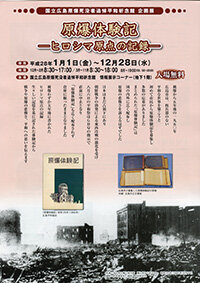
In 1950, five years after the bombing, Hiroshima City invited its residents to send stories of their experience with the atomic bomb in order to share them with others and thereby help create a peaceful world free from nuclear weapons. A total of 165 stories were collected, and of those, 18 stories were chosen to be compiled into a publication titled, Memoirs of the Atomic Bombing, copies of which were supposed to be distributed all over the country and the world in order to convey the horrors of atomic bombings.
However, due to various reasons such as the intensifying Cold War with the outbreak of the Korean War, the Peace Memorial Ceremony on August 6 that year was cancelled at the last minute by order of the GHQ (General Headquarters of the Allied Powers), which had occupied Japan. Under such circumstances, a total of 1,500 copies of "Memoirs of the Atomic Bombing" were not distributed, and had remained in a warehouse for a long time since then. These memoirs were all written within the five years after the bombing by survivors who still had fresh memories of the event. Through the records of A-bomb survivors, you will be better able to recognize the horrors of war and the atomic bombing, as well as the hope for lasting peace.
2015 (1/1-12/29)
Children of Hiroshima: Testament of the Boys and Girls of Hiroshima
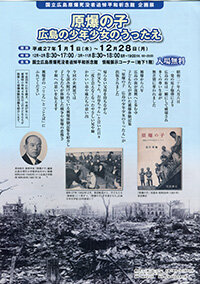
On August 6, 1945, one atomic bomb destroyed the city of Hiroshima in an instant, indiscriminately taking the precious lives of hundreds of thousands of people. Six years later, Hiroshima was busily rebuilding from the war when Genbaku no Ko (Children of Hiroshima: Testament of the Boys and Girls of Hiroshima) was as published, a collection of memoirs written by children who survived it. Recounted are days spent in tears, waiting for fathers and mothers who never came home, memories of affectionate older brothers and sisters, and adorable little brothers and sisters, who were gone forever. This special exhibition highlights this still widely read collection of memoirs by atomic bomb survivors in the hopes of conveying the devastation of the war and the atomic bomb as experienced by children, as well as their thoughts on peace.
2014 (1/1-12/29)
Children of Hiroshima: Testament of the Boys and Girls of Hiroshima
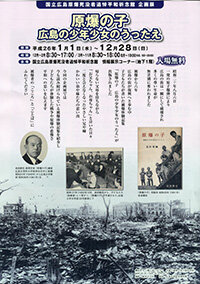
On August 6, 1945, one atomic bomb destroyed the city of Hiroshima in an instant, indiscriminately taking the precious lives of hundreds of thousands of people. Six years later, Hiroshima was busily rebuilding from the war when Genbaku no Ko (Children of Hiroshima: Testament of the Boys and Girls of Hiroshima) was published, a collection of memoirs written by children who survived it. Recounted are days spent in tears, waiting for fathers and mothers who never came home, memories of affectionate older brothers and sisters, and adorable little brothers and sisters, who were gone forever. This special exhibition highlights this still widely read collection of memoirs by atomic bomb survivors in the hopes of conveying the devastation of the war and the atomic bomb as experienced by children, as well as their thoughts on peace.
2013 (1/1-12/29)
The Road to Recovery — Surviving the Chaos after the Hiroshima Atomic Bombing
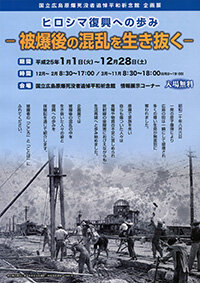
The people who lost their families and were themselves injured in the atomic bombing suffered from a lack of food and other necessities. Despite living in fear of aftereffects from radiation, they started on the path towards rebuilding their lives. Through their memoirs, this exhibition introduces people who survived the chaos after the bombing and their path to recovery.
2012 (8/1-9/30)
Special Exhibition Commemorating the 10th Anniversary of the Opening of the Hiroshima National Peace Memorial Hall for the Atomic Bomb Victims: The Layers Underneath Peace Memorial Park —Exhibits from deceased victims' portraits and survivors' memoirs of the A-bombing—
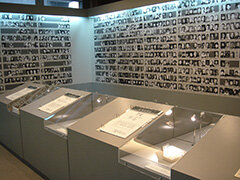
Held on the occasion of the tenth anniversary of the Hiroshima National Peace Memorial Hall for the Atomic Bomb Victims with a focus on the current Peace Memorial Park and surrounding areas, we displayed the portraits and memoirs of those who fell victim to the atomic bomb in this area, as well as pictures of area before the bombing, artifacts from the bombing discovered when the Memorial Hall was built, and a cross-section sample.
2012 (1/2-12/29)
Memories That Must Not Be Lost —With Sympathy for All Loved Ones Who Died—
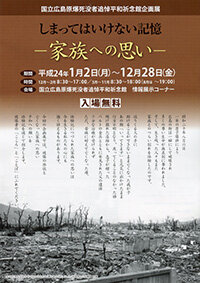
My child, whose life I couldn't save because the flames were drawing near. My elder sister, who briskly left home that morning saying "see you," is still missing. A father's remains found in a burnt and collapsed store wreckage with the buckle of the belt given to him by his son. My mother just endured the pain and died with no proper treatment available. The memories of family members in the memoirs of atomic bomb survivors can strongly touch the heartstrings of those of us who live for the moment. In this Special Exhibition, we introduce disastrous scenes after the bombing, and the survivors memories of their families, as well as their wish for peace through their memoirs.
2011 (1/2-12/28)
Memories That Must Not Be Lost —Outstretched hand of help—
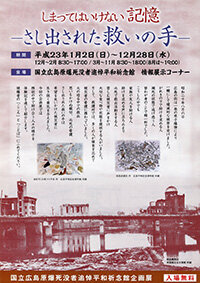
Amidst the chaos of trying to survive, there are those who stopped when they heard voices crying out for help and desperately tried to save them. There were others who provided victims with vital food and clothing. Many worked at first-aid stations, without food or rest, ceaselessly trying to provide care to the victims of the blast. All the helping hands extended when the victims were severely suffering, such as the rescues even as fires were approaching. Their unheralded kindness and desperate attempts to provide aid gave the hopeless victims the will and the courage to survive.
2010 (4/1-12/28)
Memories That Must Not Be Lost —Volunteer Citizen Corps and Building Demolition—
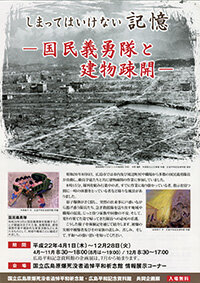
A volunteer citizen corps from the Hiroshima City, surrounding towns and villages, and local companies were working to demolish buildings to create a series of firebreaks in the city to contain fire damage from air raids. As the atomic bomb exploded, the work parties scattered, attempting to flee the sudden attack. Confusion reigned as local authorities and workplaces sent out rescue parties. Families and coworkers waited anxiously for news. Then they raced desperately to tend to the terrible injuries of the returning workers. In this exhibition, members of this volunteer citizen corps describe their experiences in the bombing.
2009 (4/1-3/31)
Memories That Must Not Be Lost —Seeking an aid station—
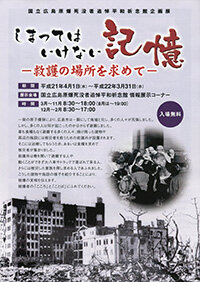
One atomic bomb reduced Hiroshima City to rubble in an instant, killing and injuring many people. With no medication or food and crowds of people fleeing, aid stations to help the victims were set up in the burned out ruins of buildings and facilities in the area. The victims went to these places seeking medical treatment or food. The 2009 Special Exhibitions highlights memoirs which describe the situation and what happened in the remains of those buildings and facilities.
2008 (4/1-3/31)
Memories That Must Not Be Lost —Plea for water—
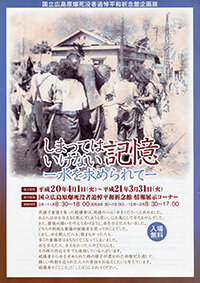
Those who had suffered terrible injuries in the atomic bombing cried out for water from the people around them. One of these people thought that giving them water would kill them, and so they did not. Another wanted to grant the suffering their last wish, and did. However, in the end, almost all of the victims died shortly, whether they received water or not. Even today, there are those who regret the decisions they made that day. This exhibition focuses mainly on introducing episodes written in memoirs about being asked for water from victims of the bombing.
2007 (4/1-3/31)
Memories That Must Not Be Lost —Leaving behind those crying for help—
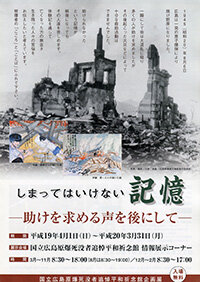
After the atomic bomb was dropped on Hiroshima, the streets were filled with scenes of chaos with vast numbers of people who needed to be rescued. The city was soon engulfed in a disastrous fire making it impossible to carry out the necessary rescue activities. This special exhibition presents the atomic bomb memoirs of those who found themselves unable to respond to the many cries for help.
2006 (4/1-3/31)
Memories That Must Not Be Lost —Roam Around Burnt Ground—
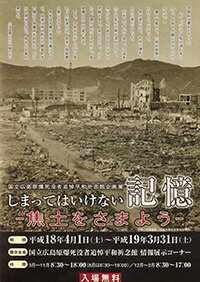
The city of Hiroshima, reduced to scorched earth by the atomic bomb, was crowded with a variety of people: the injured searching for shelter and help, others searching for and asking about the fate of family and friends. This special exhibition retraces the routes walked at that time by survivors of the atomic bombing, based on memoirs written by the survivors themselves, using maps and photographs to convey the horrors that they experienced along the way.
2005 (7/8-9/30)
The 60th Anniversary of the A-bombings Hiroshima-Nagasaki Cooperative Special Exhibition: Memories That Must Not Be Lost —Memoirs Tell the Reality of the A-Bomb Disasters—
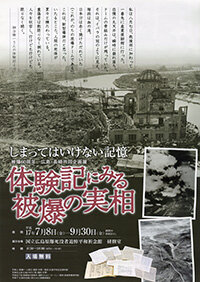
This exhibition conveyed the damages of the atomic bombing in Hiroshima and Nagasaki with special focus on the memoirs of those who survived. The memoirs and materials introduced in this special exhibition were grouped and displayed in the following categories: Prewar, Life during the War, The Dropping of Atomic Bomb, Rescue and Relief, Unending Suffering, Severed Family Bonds, Mobilized Students Victims, and A Prayer for Peace.
2005 (4/1-3/31)
Memories That Must Not Be Lost —Memoirs Tell the Reality of the A-Bomb Disasters—
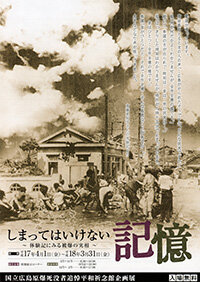
The memories of the survivors as written in their memoirs contain their pain, their grief over losing family, the haunting fears about the after-effects. Through these memoirs, we conveyed what the lasting effects that the atomic bomb had on ordinary people.
2004 (4/1-3/31 (Former Term: 4/1-9/30, Latter Term: 10/1-3/31))
Memories That Must Not Be Lost —Relief and Rescue Activities as Revealed in Memoirs—
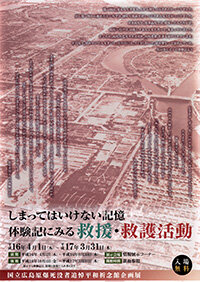
After the bombing, doctors and medical care workers continued to care for the injured despite their own injuries. This exhibition tells the stories of the rescue and care efforts of medical care workers who came to Hiroshima from outside of the prefecture responding to an official request for aid and worked tirelessly to treat the injured as written in their memoirs.
2003 (4/1-3/31 (Former Term: 4/1-9/30, Latter Term: 10/1-3/31))
Memories That Must Not Be Lost —Deprived of family members—
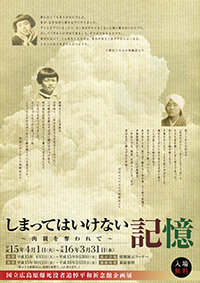
This exhibition introduces the memoirs and possessions of those who lost parents and children, husbands and wives, brothers and sisters in the atomic bombing, as well as the reflections, thoughts, and feelings of the hibakusha.
2002 (8/1-3/31, Seminar Room Exhibition held until 9/30)
Memories That Must Not Be Lost —Mobilized students as seen in A-bomb memoirs—
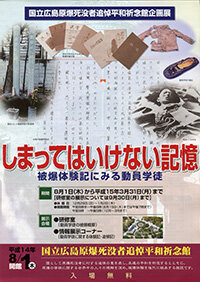
This exhibition introduces the history of mobilized students who fell victim to the atomic bombing and introduces sections of related memoirs.
Authors' rights for the video footages on this page belong to the Hiroshima National Peace Memorial Hall for the Atomic Bomb Victims. With the exception of duplication for personal use or use in excerpt which is protected by the Copyright Act, unauthorized use, duplication, reprinting, sales, alteration, or printed distribution is strictly prohibited. If you wish to use any of our materials, please contact the Memorial Hall via our Questions, Comments, Requests page in advance.
